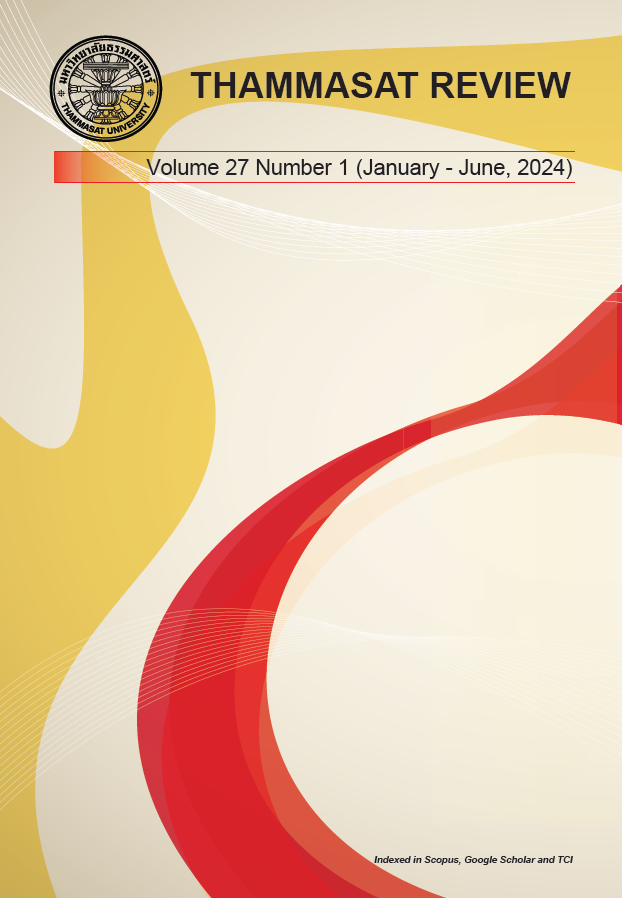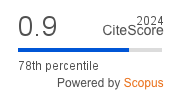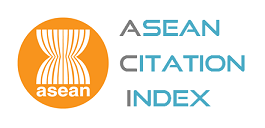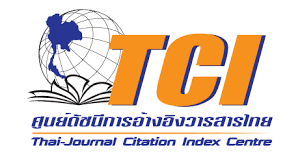The Effect of Psychological Training on Strengthening Family Behavioral Empowerment: A Path Analysis Approach
Keywords:
Family Behavioral Empowerment, Psychological Training, Interactionism Model, Path Analysis, Good Health and Well-beingAbstract
Preventing violence and strengthening family institutions require the enhancement of Family Behavioral Empowerment (FBE). Therefore, an experiment was conducted to provide psychological training, focusing on both psychological and skill development, aimed at improving FBE among Thai youths. This research investigated the effects of psychological training modules, characteristics, and situational factors on FBE. A total of 320 undergraduates from four Thai universities completed the training. Hypotheses based on the Interactionism Model were tested using structural equation modeling (SEM). The results indicated good fit indices for the path model (χ2 = 135.714; df = 111; p-value = 0.05; RMSEA = 0.02; CFI = 0.99; TLI = 0.99; SRMR = 0.06). Psychological training modules had a significantly direct effect on psychological states (TE = 0.49) and both direct and indirect effects on FBE (TE = 0.51). The training's effectiveness played an essential role in achieving favorable states and enhancing FBE. Psychological states exhibited the highest total effect on FBE (TE = 0.81), emphasizing the importance of fostering favorable psychological states. Psychological traits and situational factors were pivotal in shaping psychological states and indirectly contributing to FBE. These findings indicate the utility of training modules that integrate psychological and skills development, fostering positive attitudes and motivation for achievement towards FBE. Such interventions are crucial for strengthening family institutions and alleviating societal violence.
References
Ajzen, I., & Fishbein, M. (1980). Understanding attitudes and predicting social behavior. Englewood Cliffs, NJ: Prentice-Hall.
Alhalal, E. (2020). The effects of an intimate partner violence educational intervention on nurses: A quasi-experimental study. Nurse education in practice, 47, 102854. https://doi.org/10.1016/j.nepr.2020.102854
Baker-Henningham, H., Meeks-Gardner, J., Chang, S., & Walker, S. (2009). Experiences of violence and deficits in academic achievement among urban primary school children in Jamaica. Child abuse & neglect, 33(5), 296-306. https://doi.org/10.1016/j.chiabu.2008.05.011
Bandura, A. (1986). Social Foundations of Thought and Action: A Social Cognitive Theory. Englewood Cliffs, NJ: Prentice Hall.
Basch, C. E. (2011). Aggression and violence and the achievement gap among urban minority youth. Journal of school health, 81(10), 619-625. https://doi.org/10.1111/j.1746-1561.201100636.x
Bergman, L. R. (2001). Modern interactionism. European Psychologist, 6(3), 151–152. https://doi.org/10.1027/1016-9040.6.3.151
Bhanthumnavin, D. (2015). Antecedents of Mindful Risk-Taking Behavior in Secondary School Students: A Path Analytic Approach1. Journal of Behavioral Science Vol, 21(1). 75-94. https://ejournals.swu.ac.th/index.php/jbst/article/download/5120/4906
Bhanthumnavin, D. (2017). Psycho-social antecedents of research potentiality among graduate students: A SEM Approach. International Journal of Behavioral Science, 12(2), 50-70. https://so06.tci-thaijo.org/index.php/IJBS/article/view/94360
Bhanthumnavin, D., & Bhanthumnavin, D. (2004). Leadership effectiveness in Thailand. Leading in High Growth Asia: Managing Relationship for Teamwork and Change, 165-94.
Bhanthumnavin, D., & Bhanthumnavin, D. (2021). Academic Innovative Tales and the Enhancement of Psycho-moral Strength in Students. Warasan Phuettikammasat, 27(1), 1–17. https://so06.tci-thaijo.org/index.php/BSRI/article/view/243371
Bhanthumnavin, D., & Makanong, A. (2002). Antecedents and Consequences Concerning Students' Development Behaviors of Secondary School Mathematics Teachers (Research report). Bangkok: National Research Council of Thailand.
Bhanthumnavin, D., & Vaninthanondra, N. (2008). Multi-dimensional test construction of psychological immunity based on the philosophy of sufficiency economy. Research report. The Principal Project of Research & Development of the Thai Behavioral System National Research Council.
Bhanthumnavin, D., Chuchom, O., & Loyd, S. (1986). Familial Control of Mass Media Usage and Thai Adolescents' Psychological Characteristics. Behavioral Science Research Institute, Sinakharinwirot University.
Browne, Kevin D. & Herbert, Martin. (1997). Preventing Family Violence. Wiley–Blackwell.
Bualar, K. (2020). Promoting Proactive Behavior in Family Development with Loved and Reasoned Child Rearing Practice. Journal of Behavioral Science for Development, 12(2), 1-21. https://so02.tci-thaijo.org/index.php/JBSD/article/view/242150
Chaitawittanun, N., Bhanthumnavin, D., Bhanthumnavin, D. E., Meekun, K., Peungposop, N., & Pimthong, S. (2020). Psycho-situational path model of ambidextrous preparation for quality aging in college students. International Journal for Innovation Education and Research, 8(8), 841-852. https://doi.org/10.31686/ijier.vol8.iss8.2592
Chotratanakamol, K., Bhanthumnavin, D. L., Bhanthumnavin, D. E., Meekun, K., Pimthong, S., & Kleebbua, C. (2023). The Nomological Model of Study-Life Balance in Thai University Students. The Journal of Behavioral Science, 18(2), 116-135. https://so06.tci-thaijo.org/index.php/IJBS/article/view/262987
Chueprasertsak, P., Chupradit, P. W., & Chupradit, S. (2022). Effect of Mental Health Promotion Program on Social Media Addiction Among University Students). Journal of Interdisciplinary Research: Graduate Studies, 11(2). 1-11. http://dx.doi.org/10.2139/ssrn.4536921
Department of Women’s Affairs and Family Development. “Persistence Situation Survey Report and the Status of the Strength of the Family Development Center in the Community for the Year 2021.” https://opendata.nesdc.go.th/dataset/report. [In Thai]
Dewettinck, K., & Van Ameijde, M. (2011). Linking leadership empowerment behaviour to employee attitudes and behavioural intentions: Testing the mediating role of psychological empowerment. Personnel Review, 40(3), 284-305. https://doi.org/ 10.1108/00483481111118621
Diamantopoulos, A., Riefler, P., & Roth, K. P. (2008). Advancing formative measurement models. Journal of business research, 61(12), 1203-1218. https://doi.org/10.1016/j.jbusres.2008.01.009
Endler, N. S., & Magnusson, D. (1976). Toward an interactional psychology of personality. Psychological Bulletin, 83(5), 956–974. https://doi.org/10.1037/0033-2909.83.5.956
Endler, N. S., & Magnusson, D. (1977). The interaction model of anxiety: An empirical test in an examination situation. Canadian Journal of Behavioural Science / Revue canadienne des sciences du comportement, 9(2), 101–107. https://doi.org/10.1037/h0081612
Fishbein, M., & Ajzen, I. (1975). Belief, Attitude, Intention, and Behavior: An Introduction to Theory and Research. Reading, MA: Addison-Wesley.
Gibson, L. J., Lvancevich, M. J., Donnelly, H. J. JR., & Konopaske, R. (2011). Organization behavior structure process (14th Edition). McGraw -Hill.
Hu, L.T., & Bentler, P.M. (1999). Cutoff Criteria for Fit Indexes in Covariance Structure Analysis: Conventional Criteria Versus New Alternatives. Structural Equation Modeling, 6 (1), 1-55. https://doi.org/10.1080/10705519909540118
Hurd, N. M., Zimmerman, M. A., & Reischl, T. M. (2011). Role model behavior and youth violence: A study of positive and negative effects. The Journal of Early Adolescence, 31(2), 323-354. https://doi.org/10.1177/0272431610363160
Ishida, M., Ryosuke D., Hiroko K., Wataru I., Maki W., & Kazuo N. (2017). Development of the anger coping behaviors style scale for high school students. Kawasaki Journal of Medical Welfare, 23(1), 1-9.
Jinnge, P., Chaijukul, Y., Kramanon, S., Kasemnetr, L., Kaochim, P., Wongratana, C., Srijindarat, U., Thongpakdee, T., & Kesonpat, P. (2022). Family Strength in the Context of Thai Society: Components and Casual Factors. Warasan Phuettikammasat, 28(2), 56–79. https://so06.tci-thaijo.org/index.php/BSRI/article/view/255707
Joreskog, K. G., & Sorbom, D. (1989). LISREL 7: User's Reference Guide. Chicago, IL: Scientific Software.
Judge, T. A., Locke, E. A., Durham, C. C., & Kluger, A. N. (1998). Dispositional effects on job and life satisfaction: The role of core evaluations. Journal of Applied Psychology, 83(1), 17-34. https://doi.org/10.1037/0021-9010.83.1.17
Kolko, D. J. (1996). Individual cognitive behavioral treatment and family therapy for physically abused children and their offending parents: A comparison of clinical outcomes. Child Maltreatment, 1(4), 322-342. https://doi.org/10.1177/107755959600100400
Kongsuwan, V., Suttharungsee, W., Purnell, M. J., & Lynn, C. E. (2012). Thai adolescents and social responsibility: Overcoming violence in schools and creating peace. Research on humanities and Social Sciences, 2(11), 178-187.
Vineekarn, K., Suttharungsee, W., Purnell, M. J., & Lynn, C. E. (2012). Thai adolescents and social responsibility: Overcoming violence in schools and creating peace. Research on humanities and Social Sciences, 2(11), 178-187.
Kongsuwan, W., & Chatchawet, W. (2019). Effect of nursing intervention integrating an Islamic praying program on labor pain and pain behaviors in primiparous Muslim women. Iranian journal of nursing and midwifery research, 24(3), 220–226. http://dx.doi.org/10.4103/ijnmr.IJNMR_36_18
Krajangsaeng, K, Chanasith, K, & Chantuk, T. (2018). Causal Factors Affecting the Behavior of Violence Against Others of Middle Adolescents. Journal of Humanities and Social Sciences Thonburi University, 12(27), 97–110. https://so03.tci-thaijo.org/index.php/trujournal/article/view/110415
Lee, J. Y., Ham, O. K., Oh, H. S., Lee, E. J., Ko, Y., & Kim, B. (2022). Effects of life skill training on the school violence attitudes and behavior among elementary school children. The Journal of School Nursing, 38(4), 336-346. https://doi.org/10.1177/1059840520934183
Limsakul, M., & Phollawan, S. (2022). Expansion of Community Areas to Implement the Domestic Violence Perpetrator Program for Preventing Recidivism: Case Study in Nang Rong City Municipality, Buriram Province. Trends of Humanities and Social Sciences Research, 10(1), 338–355. https://so03.tci-thaijo.org/index.php/Humanties-up/article/view/255653
Magnusson, D. (2001). The holistic-interactionistic paradigm: Some directions for empirical developmental research. European Psychologist, 6(3), 153–162. https://doi.org/10.1027/1016-9040.6.3.153
Sanu, M., & Mahatthanadull, S. (2019). Holistic well-beings promotion for balanced way of life according to buddhist psychology. Journal of MCU Nakhondhat, 6(3), 1161-1172.
Manasathien, O., & Adunwatthanasiri, M. (2012). The Effects of Model Technique Program to Develop Achievement Motivation of Youth Boys at Rachasima Welfare. Journal of Education Khon Kaen University (Graduate Studies Research), 6(4), 153-160. https://so02.tci-thaijo.org/index.php/EDGKKUJ/article/download/50753/42002
Markowitz, F. E. (2001). Attitudes and family violence: Linking intergenerational and cultural theories. Journal of family violence, 16, 205-218. https://doi.org/10.1023/A:1011115 104282
McClelland, D. C. (1961). Achieving Society (No. 15). New York: Simon and Schuster. https://doi.org/10.1037/14359-000
McMillan, J. H., & Schumacher, S. S. (2001). Research in education: a conceptual introduction (5th ed.). Longman.
Mekkhachorn, W. (2019). Psycho-social as correlates of college adaptive behavior in lower-level undergraduate students. [Doctoral dissertation]. National Institute of Development Administration. https://doi.org/10.14457/NIDA.the.2019.27
Ming, J. L., Huang, H. M., Hung, S. P., Chang, C. I., Hsu, Y. S., Tzeng, Y. M., ... & Hsu, T. F. (2019). Using simulation training to promote nurses’ effective handling of workplace violence: a quasi-experimental study. International journal of environmental research and public health, 16(19), 3648. https://doi.org/10.3390/ijerph16193648
Ministry of Social Development and Human Security. (2018). Ministry of Social Development and Human Security's Five-Year Strategic Plan (2017-2021). Ministry of Social Development and Human Security. Bangkok.
Napa, W., Neelapaichit, N., Kongsakon, R., Chotivitayataragorn, S., & Udomsubpayakul, U. (2023). Impacts of COVID-19 on family violence in Thailand: prevalence and influencing factors. BMC women's health, 23(1), 294.
NESDC. (2016). NESDB Economic Report Thai Economic Performance in Q2 and Outlook for 2016. Macroeconomic Strategy and Planning Office.
Nonthachot, P., Yaemyuean, A., & Uansa-ard, S. (2023). A Causal Model of Psychosocial factors for Empowering Thai Youth in Preventing Domestic Violence. The Journal of Behavioral Science, 18(1), 65–83. https://so06.tci-thaijo.org/index.php/IJBS/article/ view/257842
Nunnally, J. C. (1978). Psychometric theory (2nd ed.). New York: McGraw-Hill.
Oljača, M., Dinić, B., & Sokolovska, V. (2015). The effects of attitudes towards violence on violent behaviour among secondary school students: Moderation by gender and aggressiveness. Zbornik Instituta za pedagoska istrazivanja, 47(2), 285-304. https://doi.org/10.2298/ZIPI1502285O
Pechsung, P. (2019). Development of program for enhancing learning behavior using achievement motivation theory and goal setting theory for undergraduate students. Chulalongkorn University Theses and Dissertations (Chula ETD). 9816. https://doi.org/10.58837/CHULA.THE.2019.1440
Phoraksa, T., & Lerdtomornsakul, U. (2023). Drug Addiction Rehabilitation Laws Comparing between the United States and Thailand. Journal of Thai Justice System, 16(2), 49–62. https://so04.tci-thaijo.org/index.php/JTJS/article/view/259083
Pimthong, S. (2020). The Effectiveness of Psycho-Behavioral Science Training on Promoting Prosocial Behavior of Secondary School Students. Journal of Behavioral Science for Development, 12(2), 81-100. https://so02.tci thaijo.org/index.php/JBSD/article/view/240621/165187
Podsakoff, P. M., MacKenzie, S. B., Lee, J.-Y., & Podsakoff, N. P. (2003). Common method biases in behavioral research: A critical review of the literature and recommended remedies. Journal of Applied Psychology, 88(5), 879-903.https://doi.org/10.1037/0021-9010.88.5.879
Portawin, T. (2020). Strengthening of the Warmness for Specific Family in The Target Areas of The Warm Family. Journal of Social Work, 28(1), 197–234. https://so04.tci-thaijo.org/index.php/swjournal/article/view/21763
Rappaport, J. (1981). In praise of paradox. A social policy of empowerment over prevention, in: American Journal of Community Psychology, 9(1), 1–25 (13)
Salovey, P., & Mayer, J. D. (1990). Emotional intelligence. Imagination, cognition and personality, 9(3), 185-211. https://doi.org/10.2190/DUGG-P24E-52WK-6CD
Sareerasart, W. (2011). The relationship among social situations and psychological immunity to internet behavior focusing on safety and usefulness of female students in high schools with and without internet safety project. Srinakharinwirot University.
Sareerasart, W., Vanindananda, N., & Suppareakchaisakul, N. (2012). The Relationships among Social Situations and Psychological Immunity to Internet Behavior Focusing on Safety and Usefulness of Female Students in High Schools with or without Internet Safety Project. Journal of Behavioral Science for Development Vol, 4(1).1-13. https://so02.tci-thaijo.org/index.php/JBSD/article/download/592/622/1392
Scott, K., Heslop, L., Kelly, T., & Wiggins, K. (2015). Intervening to Prevent Repeat Offending Among Moderate- to High-Risk Domestic Violence Offenders: A Second-Responder Program for Men. International Journal of Offender Therapy and Comparative Criminology, 59(3), 273-294. https://doi.org/10.1177/0306624X13513709
Seddig, D., & Davidov, E. (2018). Values, attitudes toward interpersonal violence, and interpersonal violent behavior. Frontiers in psychology, 9, 604. https://doi.org/10.3389/fpsyg.2018.00604
Seo, S. H., & Kim, S. J. (2015). The Effects of a Parental Education Program based on Satir Transformational Systemic Therapy Model for Preschoolers' Mothers. Journal of Korean Academy of Psychiatric and Mental Health Nursing, 24(4), 330-341. https://doi.org/10.12934/jkpmhn.2015.24.4.330
Sirisoonthon, S, & Rojanatrakul , T. (2021). Strong Community Strengthening in the Prevention of Family Violence. Journal of Roi Kaensarn Academi, 6(10), 459–475. https://so02.tci-thaijo.org/index.php/JRKSA/article/view/250553
Srijandari, P. & Chomeya, R. (2021). The effect of a Training Program for Developing Family Attachment among Adolescents. Journal of MCU Peace Studies. 9(5). 2102-2110. https://so03.tci-thaijo.org/index.php/journal-peace/article/view/243572/170447
Streiner, D. L., Norman, G. R., & Cairney, J. (2015). Health measurement scales: a practical guide to their development and use. Oxford University Press.
Tett, R. P., & Burnett, D. (2003). A personality trait-based interactionist model of job performance. Journal of Applied Psychology, 88(3), 500–517. https://doi.org/10.1037/0021-9010.88.3.500
Thammaraksa, P., Powwattana, A., Lagampan, S., Vatanasomboon, P., & Stoddard, S. A. (2019). Effects of School-Based Participation Program to prevent multiple risk behaviors in Thai male adolescents. Pacific Rim International Journal of Nursing Research, 23(3), 228-242. https://he02.tci-thaijo.org/index.php/PRIJNR/article/view/145791
Thaweekoon, S. (2012). The Effectiveness of Psychological Characteristics and Classroom Management Training for Internship Teachers on Student-Developing Behaviors. Education Faculty, Institute of Physical Education, Bangkok Campus.
Tucker, L. R., & Lewis, C. (1973). The reliability coefficient for maximum likelihood factor analysis. Psychometrika,38, 1-10. https://doi.org/101007/BF02291170
Upamairat, T., Kongsuwan, W., & Suttarangsee, W. (2019). The effect of a self-regulation program on attitude toward violence and self-behaviors of adolescent students. The journal of psychiatric nursing and mental health, 33(2), 13-19.
Vanindananda, N. (2017). Effects of academic innovative tales using in terms of need for achievement on moral characteristics and moral behaviors of early adolescents. (Research report). Bangkok: National Research Council of Thailand.
Walker, S. P., Wachs, T. D., Grantham-McGregor, S., Black, M. M., Nelson, C. A., Huffman, S. L., ... & Richter, L. (2011). Inequality in early childhood: risk and protective factors for early child development. The lancet, 378(9799), 1325-1338. https://doi.org/10.1016/S0140-6736(11)60555-2
Westen, D., & Rosenthal, R. (2003). Quantifying construct validity: two simple measures. Journal of personality and social psychology, 84(3), 608–618. https://doi.org/10.1037//0022-3514.84.3.608
Downloads
Published
How to Cite
Issue
Section
License
Copyright (c) 2024 Thammasat Review

This work is licensed under a Creative Commons Attribution-NonCommercial-NoDerivatives 4.0 International License.
The opinions and ideas expressed in all submissions published in Thammasat Review are solely that of the author(s) and do not necessarily reflect that of the editors or the editorial board.
The copyright of all articles including all written content and illustrations belong to Thammasat Review. Any individuals or organisation wishing to publish, reproduce and distribute a particular manuscript must seek permission from the journal first.








